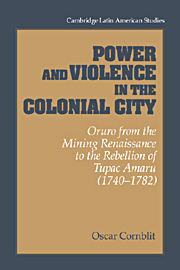 Power and Violence in the Colonial City
Power and Violence in the Colonial City Book contents
- Frontmatter
- Contents
- List of figure, maps, and tables
- Preface
- Map 1 Present-day Bolivia and surrounds
- Map 2 Principal routes of the Viceroyalty of Peru (second half of the eighteenth century)
- 1 Oruro between two epochs: a mining cycle
- 2 Under Spanish law
- 3 Oruro in 1741: details of a stormy election
- 4 The people
- 5 “Madmen, comedians, and hypocrites”
- 6 Captains of shipwreck
- 7 Returning to the known
- 8 “The fruits of the earth”
- 9 The end of an epoch: the Indian uprisings of 1780–1781
- 10 Oruro in the economic and geopolitical context of the epoch (c. 1780–1781)
- 11 The Oruro uprising
- 12 The voice of the rebels
- 13 Picking up the pieces
- Appendix A Indian raids on Oruro, 1781: testimonies
- Appendix B Testimonies of inhabitants of the city
- Appendix C Table of public jobs in Oruro, 1730–1784
- Bibliography
- Index
- CAMBRIDGE LATIN AMERICAN STUDIES
1 - Oruro between two epochs: a mining cycle
Published online by Cambridge University Press: 30 March 2010
- Frontmatter
- Contents
- List of figure, maps, and tables
- Preface
- Map 1 Present-day Bolivia and surrounds
- Map 2 Principal routes of the Viceroyalty of Peru (second half of the eighteenth century)
- 1 Oruro between two epochs: a mining cycle
- 2 Under Spanish law
- 3 Oruro in 1741: details of a stormy election
- 4 The people
- 5 “Madmen, comedians, and hypocrites”
- 6 Captains of shipwreck
- 7 Returning to the known
- 8 “The fruits of the earth”
- 9 The end of an epoch: the Indian uprisings of 1780–1781
- 10 Oruro in the economic and geopolitical context of the epoch (c. 1780–1781)
- 11 The Oruro uprising
- 12 The voice of the rebels
- 13 Picking up the pieces
- Appendix A Indian raids on Oruro, 1781: testimonies
- Appendix B Testimonies of inhabitants of the city
- Appendix C Table of public jobs in Oruro, 1730–1784
- Bibliography
- Index
- CAMBRIDGE LATIN AMERICAN STUDIES
Summary
In the forty years between 1741 and 1781, Oruro was not a sleepy little town. On the contrary, its inhabitants zealously pursued a variety of goals: they wanted to become wealthy, to hold public office both municipal and royal, to receive honors, and to wield power.
Judging by the information available to us, harmony did not reign among these people. Reading between the lines – and seeing the express words – of the documents analyzed here, we may well suspect that the so-called colonial siesta of the era was not as quiet as has been supposed. The opinions expressed by neighbors about one another were often so insulting that it is difficult to imagine how people who hated each other so intensely could coexist on a day-to-day basis within the narrow confines of a town of a few thousand inhabitants.
Of course, we are not speaking of an all-out war. Nevertheless, even taking into account that two clearly differentiated factions had formed, the actions of these Capulets and Montagues – and others as well – seem excessive for this relatively short span of time. None of them had the slightest trouble finding opportunities to launch fierce attacks against each other, as we will see in the chapters that follow.
It is to be expected that in a city whose principal activity was silver extraction, most of the energy would revolve around the mines: their possession, exploitation, financing, and provisioning. During these forty years, the town subsisted fundamentally on the mines.
- Type
- Chapter
- Information
- Power and Violence in the Colonial CityOruro from the Mining Renaissance to the Rebellion of Tupac Amaru (1740–1782), pp. 1 - 10Publisher: Cambridge University PressPrint publication year: 1995


